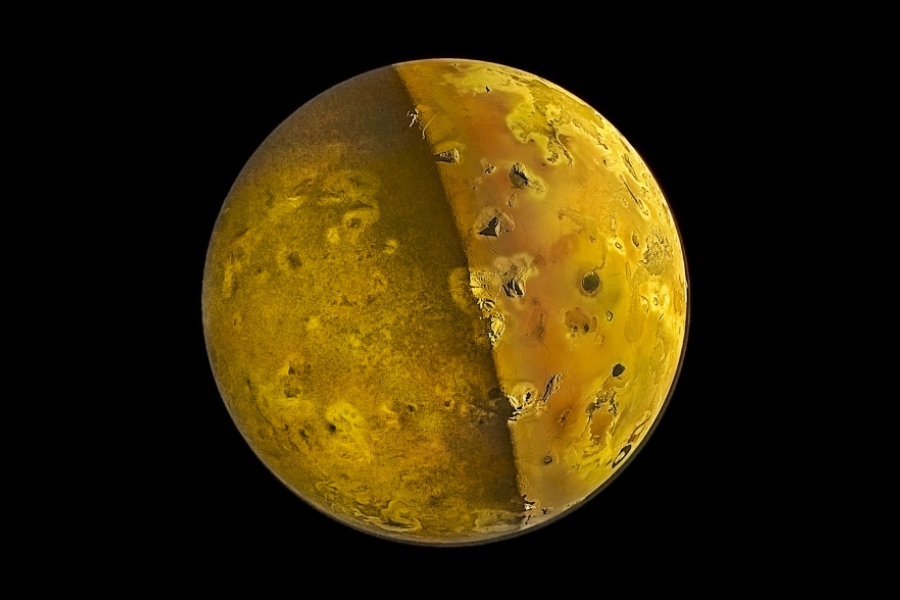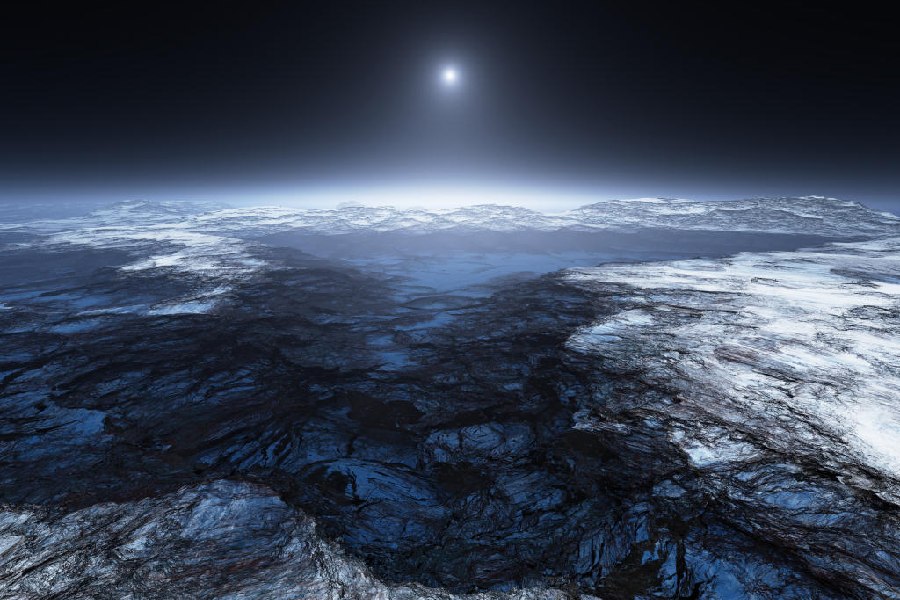Jupiter’s volcanic moon Io dazzles bright, showing signs of extreme surface changes. However, observations suggest Io may have a thin atmosphere wrapping around the tiny orbit. An atmosphere allows many planets and moons to boast a protective layer of gases, forming their outermost bubble against space. Does IO have an atmosphere? Dissecting this puzzling question reveals surprising truths about this brilliant golden moon.
We’ll explore how Io compares to our own planet to set the stage for an atmospheric assessment. Then, we are going to uncover the mystifying story of Io’s origins and violent eruptive surface, study how Io’s extreme volcanism impacted atmospheric development, and reveal fascinating insights. This guide also aims to explore the intriguing connections between volcanic activity and atmospheric development.

Does IO Have an Atmosphere?
No, Io does not have an atmosphere like Earth. It has a very thin exosphere, which is made up of gases released from its surface. But it’s not like the thick blanket of air we have on Earth.
Io’s surface is mostly bare rock and sulfur. Any gases released from its volcanoes quickly escape into space because Io doesn’t have enough gravity to hold onto them. So, while there are some gases around Io, it doesn’t have a proper atmosphere like Earth.
Subsurface Ocean Theory
Scientists have theorized that a global subsurface molten ocean may exist under Io’s crust, composed of ultra-hot pressurized magma. This would be a layer of liquid rock extending across the interior between Io’s crust and mantle.
Evidence suggests the intense gravitational forces from Jupiter’s tides drive continual internal melting that could sustain this subsurface ocean. This possible subsurface ocean could enable vital gasses to rise continuously. Sulfur dioxide and other volatiles could stream up to Io’s surface through volcanic plumes.
As the gases emerge, they supply the raw materials needed to maintain a thin atmosphere around the moon. Additionally, the cycling and outgassing of gases from a subsurface reservoir may counter atmospheric loss from other processes over time.
An underground ocean could also directly feed Io’s extreme volcanic activity at the surface by providing a vast source of pressurized magma. It may burst forth violently onto the surface as fiery lava explosions at hotspots.
This further drives the high observed volcanic output that generates the atmosphere-building gases in the first place. So, in these key ways, a subsurface is shaken in an envelope of atmospheric gases.
Evidence for a Subsurface Ocean
Evidence for an underground molten layer within Io arises from modeling Jupiter’s intense tidal heating. This tidal heating likely melts much of Io’s mantle into a widespread subsurface ocean, thicker than previously thought.
Additional evidence comes from the detection of unusual fluctuating magnetic fields around Io, which may be traced to subsurface pockets of magma and flows feeding from a global ocean below the crust.
Observations have been made of hotspot locations shifting over time on Io’s exterior surface. These observations suggest that surface volcanoes may be fed by a common subsurface magma source. This would occur through a connecting complex of lava tubes.
By corroborating independently derived magnetic measurements, surface temperature changes, and tidal heating models. The case continues to build to confirm a roiling ocean of magma deep beneath Io’s scarred visible terrain.
Current Observations of an Atmosphere on Io
Does Io moon have an atmosphere? Recent evidence provides signs Io currently has an extremely sparse atmosphere. Atmospheric modeling matching existing detections points to a very thin envelope of gases, primarily sulfur dioxide, surrounding Io.
Estimates show Io’s atmosphere could be less substantial than atmospheres on other moons. But may form through similar surface processes. More clues come from analyzing neutral atoms detected in the area where Io orbits Jupiter.
These atoms likely originate from volcanic plumes on Io, which release sulfur dioxide gases. The gases temporarily surround Io before getting stripped away. Detailed studies of Io’s volcanic plumes also reveal changes to the amount of sulfur dioxide gases during eclipse transitions from day to night.
This suggests that day-side outgassing from volcanoes helps sustain a variable transient atmosphere. The atmosphere primarily depends on continuous eruptions to replenish it.
Recent observations through various methods consistently indicate some signs. The signs are of a thin sulfur dioxide atmosphere able to briefly form and dissipate around intensely volcanic Io over day-night cycles.

Atmospheric Environment Created by Subsurface Ocean
Scientists theorize that if Io has a global subsurface magma ocean, it could significantly impact the moon’s atmosphere and surface volcanism. As Jupiter’s tidal forces melt Io’s mantle rock, magma feeds into an underground reservoir below the surface crust.
This hot, pressurized pool would occasionally burst to the surface as fiery eruptions spewed gas-rich plumes loaded with sulfur dioxide into space. Additionally, subsurface conduits could continually supply magma from the interior ocean to fuel surface volcanoes visible across Io.
Thus, an underground reservoir enables Io’s extreme observations of volcanic activity from afar. The cycle of the hypothesized subsurface ocean is welling up. And regulating eruptions helps drive critical outgassing of atmospheric gases.
Even as Io’s thin atmosphere gets lost in space. The deep melting and resultant plumes supply fresh sulfur dioxide to help recreate it when needed. The subsurface ocean would essentially power active volcanism and work to shape and maintain the tentative atmosphere detected around Io so far.
Ground-Based Observations
High-resolution ground observations of Io’s volcanic hotspots have provided insights. The insights provided are into Io’s potential atmosphere. This is by tracking surface sulfur dioxide (SO2) levels even during eclipses.
Infrared measurements detecting variability in eclipse SO2 readings affirm the following:
- Io’s atmospheric SO2 depends on sublimation from temporarily sunlit surface volcanoes.
- The marked decreases in nightside SO2 abundance compared to dayside concentrations directly showcase something.
- Io showcases an atmosphere requiring constant resupply and losing density without sunlight.
- Surface monitoring results enable modeling a transient SO2 atmosphere mediated by extreme temperature swings.
By closely tracking volatile surface manifestations from day to nighttime, ground observations provide clues. The clues are to unravel Io’s atmospheric story tied to SO2 variability. This variability is as subsurface magma intermittently feeds surface plumes, driving an atmosphere continually forming and dissipating over day-night cycles.
Temporal Variations in Plasma Torus
The unique interactions between Io and Jupiter also provide clues into Io’s atmospheric puzzle. The clues come through changes in the plasma torus encircling Jupiter. This donut-shaped ring of ionized particles derives primarily from gases escaping Io and ionized in Jupiter’s powerful magnetosphere.
Tracking the torus yields an external meter for gauging Io’s atmospheric loss and variability over time.
Regular monitoring has revealed noticeable fluctuations in the plasma torus over months and years. These fluctuations are indicative of Io’s own atmospheric instability and transient nature.
As subsurface magma injections feed Io’s prodigious volcanoes, more fresh material ejects into space, increasing supply to the rotating plasma torus for a period or until the outgassing wanes and torus density drops accordingly once more.
In addition to surface monitoring, the visual measuring stick of the plasma torus offers something else. It offers external context for pinpointing the shifting cycles. The shifting cycles are of atmospheric formation and depletion occurring around Io, when the fiery moon’s abyssal furnace powers effusive eruptions.
The particles in Jupiter’s plasma amphitheater swell in response, while lulls in activity equally ebb the ionized torus to a slower drip in this gravitationally-linked atmospheric exchange.
So, plasma torus models and measurements enable the estimation of something. They enable the estimation of both the magnitude and changeability of Io’s contributing atmospheric source regions. This is as tidal forces perpetually knead its molten innards.
Conclusion
Exploring the mysteries of does Io have an atmosphere reveals fascinating truths, highlighting the complexities in how envelopes of gas form and behave around planets across the solar system.
Analyzing the subtle clues and signatures surrounding Io’s potential ephemeral atmosphere illuminates how fleeting some gasses can be in extreme volcanic environments.
By digging into the subsurface mechanisms that may feed Io’s traces, you’ve gained a new lens for appreciating Earth’s skies. As we probe deeper into the nature of ocean worlds, we keep on questioning until a complete picture emerges of the factors allowing atmospheres to endure or vanish.
Io is but the prelude, as every body unveiled across the cosmos presents exotic alien conditions that deepen and challenge our models of atmospheric persistence. Expect even greater surprises ahead as datasets reveal the true characters of more worlds.
